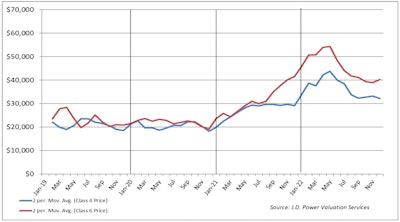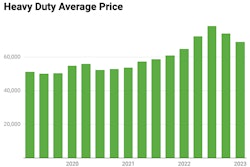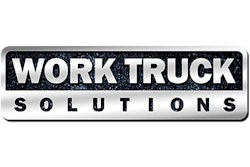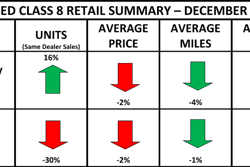
The hunt is on for attainable, appealing inventory in the used truck market.
Now almost a year removed from the industry’s unbelievable 2022 post-pandemic peak, used truck pricing continues to fall as the market regresses to historical norms. A nearly 18-month stretch of extreme undersupply has been replaced with softening demand and steady influx of equipment.
While the industry’s supernova moment has definitely passed, the used truck market hasn’t completely cratered. In segments where demand is stable, pricing remains high.
Dealers able to acquire sought-after inventory at current cycle prices are still well positioned to earn healthy profits.
“I think people are starting to understand our market as an ever increasing sine wave,” says Steve Tam, ACT Research vice president. “We may be nearing a trough, but the bottom of this trough will be higher than where we were last cycle. Much the same way last year’s peak was well higher than our previous cycle peak.”
Tam’s point can be illustrated with a quick look at recent year-over-year pricing.
According to J.D. Power, average sleeper retail prices in November 2022 were approximately $89,000. Compared to October, or even last spring, those numbers were down sharply. But that number was nearly identical to November 2021 — when the market was in ascent and approaching all-time highs.
Much negative sentiment around market conditions can be attributed to the equipment available in the space.
“Sleeper tractors with over 500,000 miles are the 800-pound gorilla [in the market],” says J.D. Power Director of Specialty Markets Chris Visser.
When new truck production slowed (and in some cases halted) in 2021, large carriers were forced to delay turning over their equipment. Trucks that needed to be offloaded were sold, but most 3- and 4-year-old models that would have typically hit the used truck space at the time instead spent another year or two in active use.
[RELATED: Used truck depreciation intensified in December]
Those units finally started hitting the secondary market last year but did so with mileage totals well beyond industry norms. For a few months that wasn’t an issue. Demand remained high. But when the fuel prices peaked and spot rates slipped in late spring, suddenly the used market had a surplus of high-mileage trucks that could no longer command record prices.
Visser says since then it’s been a steady downswing for that cohort. “Trucks in that category have been a challenge because they’re not a great substitute for a new truck, and in the second half of 2022, devalued trade-ins and tougher lending conditions exacerbated the situation.”
He adds sleepers with fewer than 450,000 miles mostly avoided that fate, “losing almost no value until late in the fourth quarter,” but were available for used truck dealers at a much lower volume.
“I think for a while we were all able to buy trucks that didn’t meet the specs and mileage descriptions of where we typically like to buy because the market was so strong,” says Arrow Truck Sales’ Nick Lombardo, purchasing and wholesale manager. “The shortage of trucks was such that if we could get a unit in good condition [during the boom], we knew we could sell it. That’s not the case anymore.”
“We’re not buying inventory just to have inventory now,” adds Andrew Ryan, director of used truck sales at Dobbs Truck Group. “Last year, we bought trucks just to meet demand.”
What are dealers buying? Depends on who you ask.
Ryan says Dobbs Truck Group paused its purchasing last year right before market crashed because it felt the tide was turning. He says the dealer group held off on adding inventory for a few months while it cleared its lots of its high-dollar investments before reentering the market later at the new price point.
[RELATED: How to find the right auction to move your aged or excess inventory]
Ryan says there’s no specific make, model or category of trucks he flat-out avoids; his purchasing today is more about prioritizing what he knows his customers covet and his sales team is comfortable supporting.
“I’m being very picky,” he says. “I’m not someone who says I won’t take this truck or that one. I’ll buy high-mileage trucks. I’ll buy wrecked trucks. If I think I can make money on a truck I’ll buy it. But I’m aware now some trucks have more value for me than others so that’s where my focus is.”
Arrow’s acquisition strategy is similar, says Lombardo. He’s always searching for 2018 model year or later sleepers with fewer than 450,000 miles, but acknowledges those have been hard to come by. With other sleepers, he’s prioritizing specific powertrain combinations that are showing the most consistent market demand for his locations.
Speaking of consistency, both dealers note day cabs continue to outpace their sleeper counterparts both in pricing and demand. Lombardo says he receives inquiries regularly from wholesalers looking for day cab packages since supply levels are not as high. Additionally, Tam notes because most day cab buyers are private fleets, that segment of the market hasn’t been impacted by the volatility of freight rates over the last year.
“Day cabs are selling well, but that’s always the case [in a slowdown] because there aren’t as many of them,” says Ryan. “Over-the-road sleepers are what is sold to a lot of first-time truck buyers, so when they exit the market, that’s where we get a surplus of equipment.”
Visser says the industry’s data bears that out, with late-model day cabs depreciating 2.4% per month in the latter half of 2022 compared to 3.6% for sleepers.
[RELATED: As average length of haul falls and e-commerce grows, how is the truck population changing]
Specialty equipment also has avoided the worst of the pricing swoon.
The e-commerce explosion born out of the pandemic has created a solid demand floor in the medium-duty space that is enabling dealers to maintain solid sales volumes despite lower prices. Additionally, industries such as refuse and construction continue to grow despite softening overall economic conditions, which has kept vocational prices from cratering.
“Those markets are much more stable because they’re not as beholden to freight,” says Tam. “The customers buying those trucks are buying them for their businesses.”
 Average wholesale prices for Class 4 and 6 conventionals over the past four years, per J.D. Power.J.D. Power Valuation Services
Average wholesale prices for Class 4 and 6 conventionals over the past four years, per J.D. Power.J.D. Power Valuation Services
Adds Visser, “Medium-duty conventionals are exposed to almost every segment of the macroeconomy, so any pullback in demand in one sector has so far made up for by continued strength in another sector.”
Arrow doesn’t move much vocational inventory due to the regionalization demands of the equipment, but Lombardo says he has heard good things about pricing and demand. He adds that’s a segment of the market that’s been undersupplied for a decade or more, so it’s not surprising to see pricing holding up better than the Class 8 space.
“There’s been a strain on that market dating back to 2008,” he says.
As for when the market will hit the road to recovery, sentiment is mixed.
The gulf between retail and wholesale/auction prices would indicate more market contraction is necessary for the sector to reset into historical norms. Tam says the major depreciation hit retail inventory received last month should slow as the year progresses and says monthly and year over year comps “are going to get easier” after the first quarter. Visser agrees, noting J.D. Power research indicates “if sleeper tractors continue to depreciate at roughly 4% per month, that’s five months before they hit 2018 pricing. Depreciation should start to relax at a point not long after that.”
In the meantime, dealers will need to continue acquiring inventory cautiously and managing pricing proactively.
Ryan says Dobbs intends to sustain the practices it put in place last year as it enabled the company to attain inventory at viable prices for retail success. He also says the dealer group will remain focused on volume and will carefully alter prices to turn trucks consistently rather than hold out for large dollar sales. He says the market isn’t strong enough to enable that tactic anymore.
Lombardo agrees. “We had a past president who liked to say used trucks are like a fish market. You want to sell the fresh stuff. If it sits too long, it starts to stink.”
And quality inventory is still commanding good prices.
“Sales are softer but profitability is still good. The trucks we’re selling, we’re holding the profits in them,” Lombardo says.
Adds Tam, “I think you have to remember where we’re falling from. You’re not going to be lighting cigars with $100 bills anymore — but you might be with $10 bills.”











